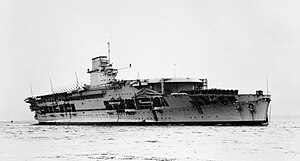Our website is made possible by displaying online advertisements to our visitors.
Please consider supporting us by disabling your ad blocker.
HMS Courageous (50)
 Courageous shortly after completion in 1916
| |
| History | |
|---|---|
| Name | Courageous |
| Ordered | 14 March 1915 |
| Builder | Armstrong Whitworth |
| Cost | £2,038,225 |
| Yard number | 895 |
| Laid down | 26 March 1915 |
| Launched | 5 February 1916 |
| Completed | 4 November 1916 |
| Reclassified | Converted to aircraft carrier, June 1924 – February 1928 |
| Identification | Pennant number: 50 |
| Nickname(s) | Outrageous[1] |
| Fate | Sunk by U-29, 17 September 1939 |
| General characteristics as battlecruiser | |
| Class and type | Courageous-class battlecruiser |
| Displacement | |
| Length | 786 ft 9 in (239.8 m) |
| Beam | 81 ft (24.7 m) |
| Draught | 25 ft 10 in (7.9 m) |
| Installed power |
|
| Propulsion | 4 shafts; 4 geared steam turbines |
| Speed | 32 knots (59 km/h; 37 mph) |
| Range | 6,000 nmi (11,000 km; 6,900 mi) at 20 knots (37 km/h; 23 mph) |
| Complement | 842 |
| Armament |
|
| Armour |
|
 Courageous as an aircraft carrier in 1935
| |
| General characteristics as aircraft carrier | |
| Class and type | Courageous-class aircraft carrier |
| Displacement |
|
| Length | |
| Beam | 90 ft 6 in (27.6 m) (at waterline) |
| Draught | 27 ft 9 in (8.5 m) |
| Installed power |
|
| Propulsion | 4 shafts, 4 geared steam turbines |
| Speed | 30 knots (56 km/h; 35 mph) |
| Range | 5,860 nautical miles (10,850 km; 6,740 mi) at 16 knots (30 km/h; 18 mph) |
| Complement | 814 + 403 air group (1938) |
| Armament | 16 × single 4.7 in (120 mm) AA guns |
| Armour |
|
| Aircraft carried | 48 |
HMS Courageous was the lead ship of her class of three battlecruisers built for the Royal Navy in the First World War. Designed to support the Baltic Project championed by First Sea Lord John Fisher, the ship was very lightly armoured and armed with only a few heavy guns. Courageous was completed in late 1916 and spent the war patrolling the North Sea. She participated in the Second Battle of Heligoland Bight in November 1917 and was present when the German High Seas Fleet surrendered a year later.
Courageous and Glorious were decommissioned after the war and laid up, then rebuilt as aircraft carriers in the mid-1920s. Courageous and Glorious could carry 48 aircraft, compared with 36 carried by their half-sister Furious on about the same displacement. After recommissioning Courageous spent most of her career operating off Great Britain and Ireland. She briefly became a training ship, but reverted to her normal role a few months before the start of the Second World War in September 1939. Later that month, German U-boat torpedoed Courageous which sank with the loss of more than 500 of her crew.
Previous Page Next Page


